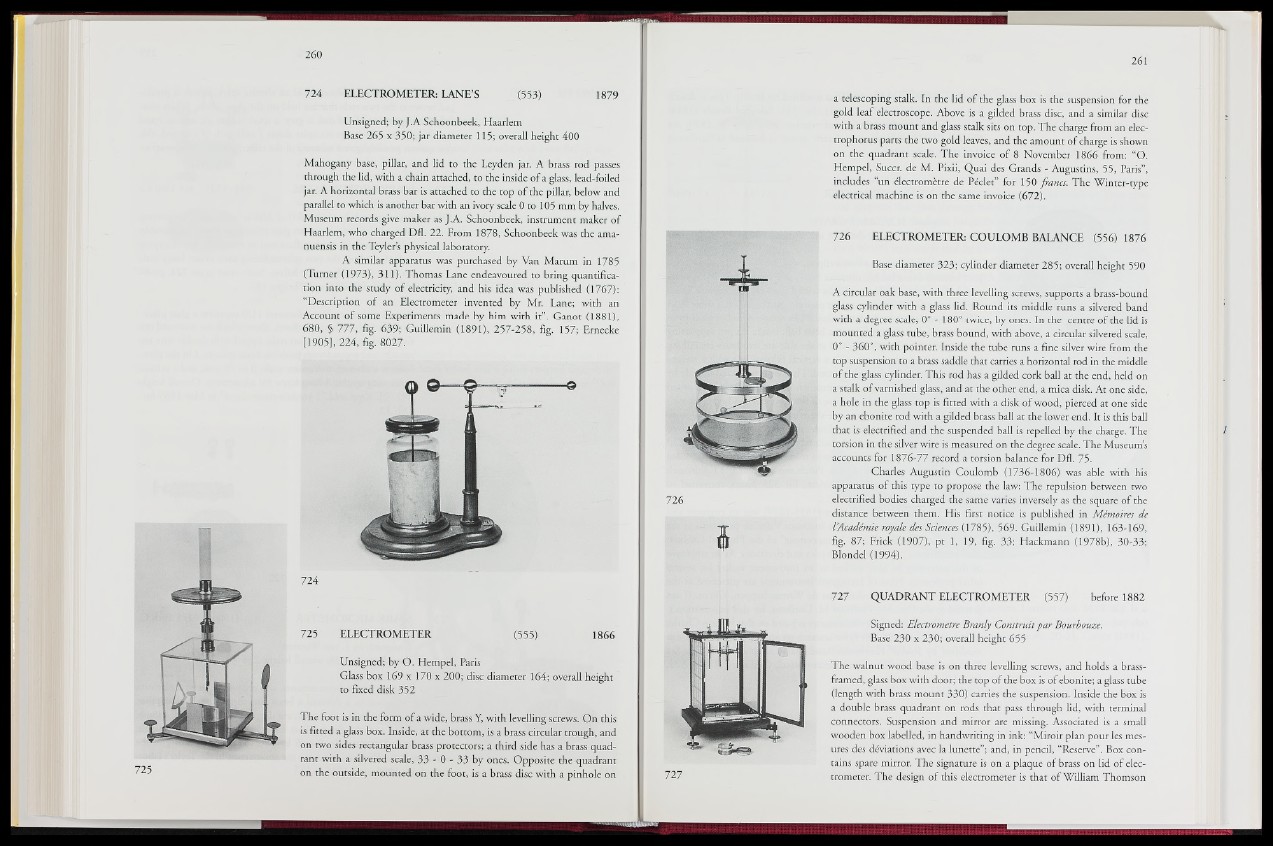
724 ELECTROMETER: LANE’S (553) 1879
Unsigned; by J A Schoonbeek, Haarlem
Base 265 x 350; jar diameter 115; overall height 400
Mahogany base, pillar, and lid to the Leyden jar. A brass rod passes
through the lid, with a chain attached, to the inside of a glass, lead-foiled
jar. A horizontal brass bar is attached to the top of the pillar," below and
parallel to which is another bar with an ivory scale 0 to 105 mm by halves.
Museum records give maker as J.A. Schoonbeek, instrument maker of
Haarlem, who charged Dfl. 22. From 1878, Schoonbeek was the amanuensis
in the Teyler’s physical laboratory.
A similar apparatus was purchased by Van Marum in 1785
(Turner (1973), 311). Thomas Lane endeavoured to bring quantification
into the study of electricity, and his idea was published §$767):
“Description of an Electrometer invented by Mr. Lane; with an
Account of some Experiments made by him with it”. Ganot (1881),
680, § 777, fig. 639; Guillemin (1891), 257-258, fig. ii57; Ernecke
[1905], 224, fig. 8027P1
724
725 ELECTROMETER (555) 1866
Unsigned; by O. Hempel, Paris
Glass box 169 x 170 x 200; disc diameter 164; overall height
to fixed disk 352
The foot is in the form of a wide, brass Y, with levelling screws. On this
is fitted a glass box. Inside, at the bottom, is a brass circular trough, and
on two sides rectangular brass protectors; a third side has a brass quadrant
with a silvered scale, 33 - 0 - 33 by ones. Opposite the quadrant
on the outside, mounted on the foot, is a brass disc with a pinhole on
a telescoping stalk. In the lid of the glass box is the suspension for the
gold leaf electroscope. Above is a gilded brass disc, and a similar disc
with a brass mount and glass stalk sitS on top. The charge from an elec-
trophorus parts the two gold leaves, and the amount of charge is shown
on the quadrant Scale. The invoice of 8 November 1866 from: “O.
Hempel, Succr. de M. Pixii, Quai des Grands - Augustins, 55, Paris”,
includes “un dlectromkre de l* |le t” for 150 francs. The Winter-type
electrical machine is on the same invoice (672).
726
S
726 ELECTROMETER: COULOMB BALANCE (556) 1876
Base diameter 323; cylinder diameter 285; overall height 590
A circular oak base, with three levelling screws, supports a brass-bound
glass cylinder with a glass lid: Round its middle runs a silvered band
with a degree s’cal'e,' 0“ - 180° twice, by ones. In the centre of the lid is
mounted a glass tube, brass bound, with above, a circular silvered scale,
0° - 360°, with pointer. Inside the tube runs a fine silver wire from the
top suspension to a brass saddle that carries a horizontal rod in the middle
of the glass cylinder. This rod has a :|ld e d cork b|j§ at the end, held on
n | stalk of varnished glass, and at the other end, a mica disk. At one side,
a hole in the glass top is fitted with a disk of wood, pierced at one side
-by an ebonite rod with a gilded brass ball at the lower end. It is this ball
that is electrified and the suspended M l is repelled by the charge. The
torsion in the silver wire is measured on the degree scale. The Museums
accounts for 1876-77 record a torsion balance for Dfl. 75.
Charles: Augustin Coulomb (1736- 1806) was able with his
apparatus of this type to propose t |j | law: The repulsion between two
electrified bodies charged the same varies inversely as the square of the
distanceifjetween them. His first notice is published in Mémoires de
l'Âtadémie royale des S ei^^m {l785), 56J$Guillemin (1891), 163-169,
fig. 87; Frick.(1907), pt 1, 19,-fig. 33; Hackmann (1978b), 30-33;
Blondel (1994).
727 QUADRANT ELECTROMETER (557) before 1882
727
Signed: Electrometre Branly Construit par Bourbouze.
Base 230 x 230; overall height 655
The walnut wood base is on three levelling screws, and holds a brass-
framed, glass box with door; the top of the box is of ebonite; a glass tube
(length with brass mount 330) carries the suspension. Inside the box is
a double brass quadrant; on rods that pass through lid, with terminal
.connectors. Suspension and mirror are missing. Associated is a small
wooden box labelled, in handwriting in ink: “Miroir plan pour les mes-
ures des deviations avec la lunette”; and, in pencil, “Reserve”. Box contains
spare mirror. The signature is on a plaque of brass on lid of electrometer.
The design of this electrometer is that of William Thomson